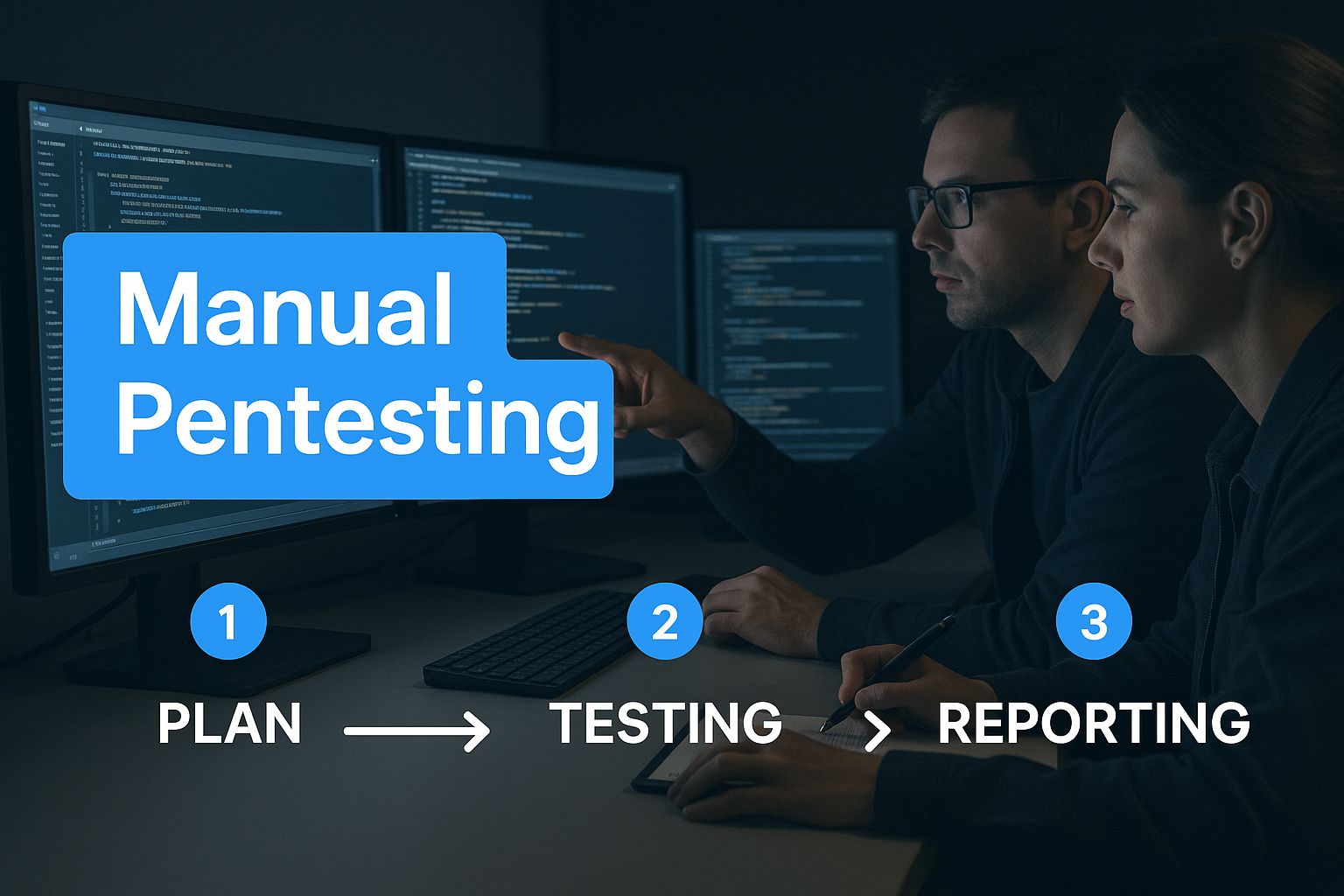An external penetration test is a simulated cyberattack that goes after your client's internet-facing systems—think websites, servers, and anything else you can see from the outside world. The goal is to find security holes before the real hackers do. It’s like hiring a professional to check every digital door and window of a building from the street.
Our experts, armed with top-tier certifications like OSCP, CEH, and CREST, perform these tests manually. This human-led approach uncovers genuine business risks that automated scanners almost always miss. We provide this service quickly and affordably, so you can offer your clients the best without the high price tag.
Understanding What External Penetration Testing Is
So, what is an external penetration test, really? It's a critical security service where ethical hackers try to break into your client's network from the outside. Imagine your client’s business is a fortress. An external test focuses only on the outer walls, gates, and any potential secret entrances an attacker could use to get inside.

This isn’t just about running a simple scan. While automated tools can flag some issues, a manual pentesting approach goes much deeper. Our certified ethical hackers think creatively, just like real attackers. They don't just find an unlocked door; they see what's behind it, all in a controlled and safe way. This hands-on method is the only way to confirm which vulnerabilities pose a genuine business risk.
Why Manual Pentesting Beats Automated Scans
For MSPs, vCISOs, and GRC companies, understanding the difference between automated scanning and manual testing is key. Automated tools are okay at finding obvious problems, but they're known for flagging issues that aren't real (false positives) and missing complex flaws entirely. A manual approach provides the human intelligence that software just can't replicate.
Our team looks for real-world issues like misconfigured firewalls, outdated server software, weak passwords on login pages, and business logic flaws in web applications. We test authentication bypasses, privilege escalation paths, and chained vulnerabilities that automated scanners would never detect. While a scanner sees your network as data points, our experts see it the way an attacker would.
To make it clear, let's compare them side-by-side:
Automated Scanning:
- Finds known vulnerabilities from a database
- Generates hundreds of false positives
- Can't understand business context
- Misses logic flaws and complex attack chains
- Runs the same tests every time
- Delivers a generic report full of noise
- Takes minutes but provides shallow results
Manual Penetration Testing:
- Discovers unknown and zero-day vulnerabilities
- Validates every finding before reporting
- Understands your specific business logic
- Identifies complex multi-step attacks
- Adapts testing based on discoveries
- Provides actionable, prioritized findings
- Takes days but uncovers real risks
As you can see, manual testing isn't just a "better" scan, it's a completely different service that delivers true security assurance. When your clients ask why they need more than automated scanning, you can confidently explain that manual testing finds the vulnerabilities that actually get exploited, not just the ones that show up in compliance reports.
Why Your Clients Need External Penetration Testing
For your clients, external penetration testing isn't just another IT expense; it's a core business need. This demand usually comes from two places: compliance mandates and genuine risk assessment. An external pentest delivers the concrete evidence auditors need, taking a client from just saying they're secure to proving it with a detailed, third-party report.
This report is a golden ticket during audits for frameworks like SOC 2, HIPAA, PCI DSS, and ISO 27001. When you offer this service, you become the partner who helps them meet high-stakes compliance requirements. Failing an audit can lead to massive fines, lost contracts, and a damaged reputation. An external penetration test is one of the clearest ways to show due diligence.
How Pentesting Helps Meet Compliance Requirements
While compliance often gets clients in the door, the real value of an external penetration testing engagement is in genuine risk assessment. It answers the one question every business owner wants to know: "Where are we most vulnerable right now?" An automated scanner will give you a long list of "potential" issues, but a manual pentesting report tells you which vulnerabilities are actually exploitable and dangerous.
This is a game-changer. It allows your clients to make smart, targeted decisions with their security budget. Instead of wasting money on generic tools, they can fix the specific, confirmed weaknesses that pose a real threat. By providing a fast and affordable pentesting solution, you make it a no-brainer for clients to check this box and stay secure.
The Growing Need For Proactive Security
The demand for this kind of security validation is exploding. As cyber threats get more creative, the global external penetration testing market is growing right alongside them. Projections show the market growing significantly, a direct response to the non-stop barrage of cyberattacks. You can dig into the numbers on the penetration testing market growth on cognitivemarketresearch.com.
By offering white label pentesting, you can tap into this surging demand without the headache of building your own security team. We handle the expert, manual pentesting your clients need, and we deliver it quickly and at a price that makes sense for the channel. This lets you, the trusted MSP or vCISO, solve the industry-wide problem of inflated pricing and long lead times, making you even more valuable.
Our Manual External Pentesting Process Explained
A great external penetration testing process is one you can explain to your clients simply. We use a clear, step-by-step methodology that’s all about expert human analysis, not confusing jargon. No black boxes here—just a straightforward process built to find risks that matter to your clients' business.
This infographic breaks down the core stages of our manual approach. It shows exactly how our certified cybersecurity experts systematically find and validate vulnerabilities.

As you can see, our manual pentesting flows from initial planning to the final report, guaranteeing that every finding is confirmed by one of our certified professionals.
How We Scope Your Pentesting Engagement
Before we start, we work with you to define the scope. Think of it as setting the rules of the game. We'll agree on the client's goals, which internet-facing systems are in play, and what the boundaries are for the test. This conversation is critical for a successful penetration testing engagement. It ensures our team’s efforts are focused on what actually matters for the client's business and their compliance requirements, whether it's for SOC 2 or PCI DSS.
Once the scope is set, our pentesters begin the reconnaissance phase. This is the detective work. Our experts dig up publicly available information about your client’s organization, just like a real attacker would. They look for employee names, email patterns, and the technologies in use. This information helps us map the external attack surface and sets the stage for the hands-on testing.
Vulnerability Analysis And Hands-On Exploitation
Now for the main event: vulnerability analysis and exploitation. This is where the skills of our OSCP and CEH certified testers shine. Using the information gathered, they manually probe the target systems for weaknesses. Our team doesn’t just run a scanner; they actively try to exploit the vulnerabilities they find in a safe and controlled way. This is the step that separates real, exploitable risks from theoretical ones.
The most important stage is reporting. We deliver a comprehensive, easy to read report that you can white label and hand directly to your client. It breaks down every vulnerability, explains the potential business impact in plain English, and provides clear, actionable steps for remediation. It’s designed to help your clients fix what matters most, making it a powerful tool for any MSP or vCISO.
Grow Your Business With White Label Pentesting
Partnering with us for white label pentesting is how you get a serious edge in a crowded market. Our business model is 100% channel-only, which means we only work through partners like you. We are your affordable alternative to overpriced and slow providers. We never compete with our MSP or vCISO clients. Think of us as your silent, behind-the-scenes security team, ready to go when you need us.
By reselling our services, you can instantly add a high-demand security offering to your portfolio. This lets you open up new revenue streams and build deeper trust with your clients—all without the huge cost and headache of hiring your own ethical hackers. Our team is fast, and our pentesters hold certifications like OSCP, CEH, and CREST.
How In-House Compares To A Partnership
Building an in-house penetration testing team is a massive project. You have to find and hire expensive, certified talent, buy specialized tools, and manage a complex workflow. Our white label pentesting program lets you skip all that. We do the heavy lifting, delivering a fast, affordable, and thorough report branded with your logo. You present it as your own, strengthening your role as a security advisor.
The financial and operational differences are stark. For most MSPs or vCISOs, choosing a white-label partner is one of the smartest business decisions you can make. It frees you up to do what you do best: manage client relationships and grow your business.
ConsiderationBuilding an In-House TeamPartnering for White Label PentestingInitial Cost$150,000+ for salaries, tools, and training$0 initial investment. You only pay for the tests you sell.Time to Market6-12 months to hire, train, and build processesImmediate. You can start selling our services today.ExpertiseRequires constant training to keep up with new threatsAccess to a dedicated team of certified, experienced pentesters.ScalabilityDifficult to scale up or down based on client demandEffortlessly scale. We handle any volume of tests you need.
Partnering is the clear winner for any reseller looking to offer external penetration testing services without crippling their budget.
Become The One-Stop Shop For Security
When your clients need a pentest for a compliance requirement like SOC 2, HIPAA, or PCI DSS, you want to be the one they call. If you can't provide it, they'll find someone else. That opens the door for a competitor to swoop in and start chipping away at your other services.
By offering a solid risk assessment through us, you close that gap. You become their single source for all things security and compliance. This adds a sticky, high-value service to your lineup and locks you in as their essential partner. To learn more, check out our guide on manual, white-labeled pentesting.
Common Vulnerabilities Our Pentesters Discover
So, what does a manual external penetration testing engagement really find? The value comes from our certified experts who think like attackers. They aren't just ticking boxes; they're uncovering business-logic flaws and chaining together small exploits that can lead to major breaches. Here are some of the most common and high-impact vulnerabilities our team finds every day.

One of the most frequent things we find is outdated software on public-facing servers. An automated scan might flag an old system, but it won't tell you if the vulnerability is actually exploitable in that environment. Our manual pentesting process takes it a step further. We safely show how an attacker could use that outdated component to get a foothold, turning a low-priority notification into an urgent fix.
Misconfigured Cloud Services And Weak Credentials
Cloud infrastructure is flexible, but also very easy to misconfigure. A single wrong setting in a cloud storage bucket can expose sensitive client data to the internet. We find these kinds of issues all the time. These misconfigurations are subtle and almost always missed by scanners because they can't understand the business context of the data.
Weak or default passwords on login portals are another classic entry point for attackers. Our team tests for weak password policies and other authentication weaknesses. More importantly, our testers hunt for ways to bypass authentication entirely—complex flaws that a scanner will never find. Confirming these vulnerabilities is a key part of a thorough risk assessment and something we cover in our guide on security vulnerability scanning.
How We Make Pentesting A Recurring Service
The best way to protect your clients is to treat external penetration testing as an ongoing program, not a one-time event. Think of it like an annual health check for their business. A regular pentest finds security holes before they become a headline-making breach. This isn't just better security for them; it's a smarter business model for you, creating a reliable, recurring revenue stream.
When you talk to your clients, use an analogy they'll get. An annual penetration test is like a yearly physical. Their tech environment is always changing, and any one of those changes can accidentally open a new door for an attacker. An annual pentest gives you a consistent baseline of your client's security posture and provides the proof auditors need for SOC 2 or HIPAA.
When To Test After Major System Changes
While an annual test is the perfect baseline, you should also pitch external penetration testing after any big infrastructure change. These are the moments when new security gaps are most likely to appear. This includes launching a new website, migrating to a new cloud provider, or major software updates. By baking pentesting into these workflows, you help clients manage risk proactively.
As your white label pentesting partner, we make it simple to deliver this critical recurring service. Our expert team of OSCP and CEH certified pros provides the deep-dive manual analysis your clients need. We handle all the technical heavy lifting, so you can focus on building strong client relationships. Contact us today to learn how our channel-only program can help you build a profitable, recurring pentesting service.
Common Questions About External Penetration Testing
You've got questions about how this all works, and we have straight answers. Here are the most common things we hear from MSPs, vCISOs, and other resellers.
A standard external penetration testing engagement for one of your clients typically takes about one to two weeks. That’s from kickoff to the final report landing in your inbox. We deliver real, manual pentesting results much faster than the industry norm because we know speed is critical for you and your clients.
A vulnerability scan is an automated tool that spits out a list of potential problems, often with many false positives. Our external penetration testing is a hands-on process. Our certified pros (OSCP, CEH, CREST) don't just find holes; they ethically exploit them to prove what's a genuine threat, giving you a real-world risk assessment.
Of course. Our entire service is built to be a white label pentesting solution. We provide a polished, comprehensive report that you can put your own logo on. Present it to your client as your own premium security offering—we're your silent partner in the background, helping you look like the hero.
An external penetration test is a mandatory requirement for frameworks like SOC 2, HIPAA, and PCI DSS. While it's a huge piece of the puzzle, some regulations also call for other types of security assessments, like internal penetration testing. We can help you figure out the exact scope to ensure your client's GRC needs are completely covered.
Ready to add a profitable, high-demand security service to your offerings? Partner with us to deliver fast, affordable, and expert-led white label pentesting. We are the solution to inflated prices, bad testing, and long lead times.

.avif)
.png)